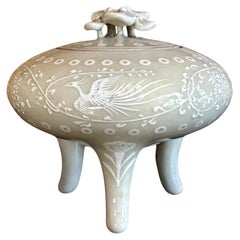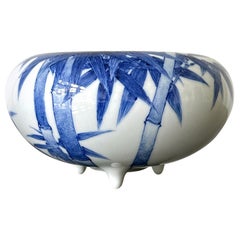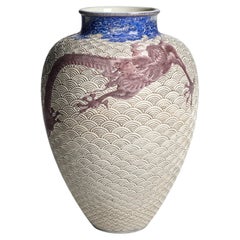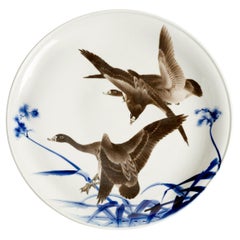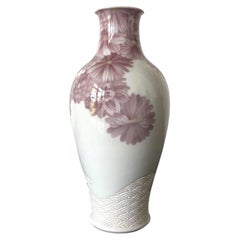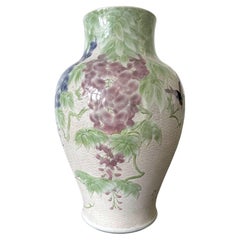Ceramics
24
to
23
1
24
24
24
7
17
17
9
2
24
9
1
1
24
24
24
306
37
24
21
19
Creator: Makuzu Kozan
Rare Japanese Porcelain Incense Burner with Inlays Makuzu Kozan
By Makuzu Kozan
Located in Atlanta, GA
A porcelain incense burner (koro) made by Japanese potter Makuzu Kozan (also known as Miyagawa Kozan, 1842-1916) circa 1890s-1900s (end of Meiji Period). The koro features an elegant...
Category
Late 19th Century Japanese Meiji Antique Ceramics
Materials
Ceramic
Rare Japanese Porcelain Painted Footed Dish Makuzu Kozan
By Makuzu Kozan
Located in Atlanta, GA
A rare footed dish in the form of an open scroll painting with literati landscape from the studio of Japanese Potter Makuzu Kozan. Also known as Miyagawa Kozan (1842–1916), Makuzu wa...
Category
Early 1900s Japanese Meiji Antique Ceramics
Materials
Porcelain
Japanese Glazed Ceramic Bowl by Makuzu Kozan
By Makuzu Kozan
Located in Atlanta, GA
Tri-pod ceramic bowl likely used as an incense burner (koro) by Japanese Imperial potter Makuzu Kozan (1842-1916) circa late Meiji period. The signature indicates that it was produce...
Category
1880s Japanese Meiji Antique Ceramics
Materials
Ceramic
Large Japanese Ceramic Vase by Makuzu Kozan Meiji Period
By Makuzu Kozan
Located in Atlanta, GA
A large Japanese ceramic vase by the celebrated Meiji imperial potter Makuzu Kozan (1842-1916) circa 1880-1890s. Dated to his underglaze phase post 1887 after he successfully mastered the new colors available from the west and used them to the best advantage in his work deeply rooted in Japanese aesthetics. The vase has an impressive size and was potted in the classic baluster form with an elegant proportion. The surface is decorated using a combination of techniques of low relief sculpturing...
Category
Late 19th Century Japanese Meiji Antique Ceramics
Materials
Ceramic
Rare Large Japanese Porcelain Presentation Plate Makuzu Kozan
By Makuzu Kozan
Located in Atlanta, GA
A large presentation plate with striking pictorial design from the studio of Japanese Potter Makuzu Kozan. Also known as Miyagawa Kozan (1842–1916),...
Category
Early 20th Century Japanese Meiji Ceramics
Materials
Porcelain
Japanese Ceramic Vase with Delicate Carvings by Makuzu Kozan Meiji Period
By Makuzu Kozan
Located in Atlanta, GA
A delicate and rare Japanese ceramic vase by the important Meiji imperial potter Makuzu Kozan (1842-1916) circa 1887-1910. Dated to his underglaze phase post 1887 after he successful...
Category
1890s Japanese Japonisme Antique Ceramics
Materials
Ceramic
Japanese Ceramic Centerpiece Bowl Makuzu Kozan Meiji Period
By Makuzu Kozan
Located in Atlanta, GA
A beautiful ceramic vessel in the form of Bo, the so-called monk's alms bowl from the studio of Japanese Potter Makuzu Kozan, also known as Miyagawa Kozan (1842–1916), one of the most established and collected ceramist from Meiji Period. Born as Miyagawa Toranosuke, Kozan established his pottery studio in Yokohama circa 1870s and later became one of the appointed artists to the Japanese Imperial household. His work was exhibited in many international fairs that the Meiji government participated at the turn of the century and won many grand prizes.
Of a relatively large size, this piece was made as a decorative center piece for display. It was brilliantly decorated with underglaze paint of a green-on-green bamboo motif, using the novel technique developed by Kozan called Fuki-e (the blow painting). As a result, the bamboos appear took on a three-dimensional quality as if appearing in a mist. Known as one of the most creative ceramists, circa 1887, Kozan started experimenting with new chemical colors from the West in the format of his porcelain glaze. New colors allowed him to create underglaze design that appeared bright, smooth and glossy. To create design that is realistic and dimensional, more common in the western paintings, he was inspired by the native Japanese ink painting technique developed around 1900 by Yokoyama Taikan...
Category
Early 1900s Japanese Japonisme Antique Ceramics
Materials
Ceramic
Japanese Glazed Ceramic and Silver Koro Incense Burner Makuzu Kozan
By Makuzu Kozan
Located in Atlanta, GA
A tri-pod ceramic incense burner (koro) by Japanese Imperial potter Makuzu Kozan (1842-1916) circa late Meiji to the start of Taisho period (1890-1910s). A fine example of the artist's work belonging to the late part of his underglaze paint phase (started around 1887 until his death), the surface of the koro was painted in beautiful shades of blue to depict a continuous landscape not unlike a traditional ink and watercolor hand scroll. The rise and fall mountains recede and fade into the horizon and are dotted with groves of pines. The sky is painted with a beautiful subtle shade of pink, suggesting a time of sunrise or sunset. The koro is fitted with an ensuite reticulated sterling silver hoya (incense cover), pierced with swirling cloud and marked with "pure silver' in Kanji. The base is signed in underglaze blue "Makuzu Kozan Sei" within a double ring. The piece is beautifully potted in form and the decoration was done with expertise using the novel technique developed by Kozan called Fuki-e (the blow painting), in order to achieve the striking landscape known as "Mountain and Water" with sense of dimensions and gradient, the poetic effects normally conveyed only by sumi ink staining on paper. The piece comes with an unsigned tomobako (wood storage box) of a recent age.
Also known as Miyagawa Kozan (1842–1916), Makuzu Kozan was one of the most established and collected ceramist from Meiji Period. Born as Miyagawa Toranosuke, Kozan established his pottery studio in Yokohama around 1870s and later became one of the appointed artists to the Japanese Imperial household. His work was exhibited in many international fairs that the Meiji government participated at the turn of the century and won many grand prizes. Being one of the most creative ceramists, Kozan started experimenting with new chemical colors from the West in the format of his porcelain glaze around 1880s. New colors allowed him to create underglaze designs that appeared bright, smooth and glossy. He even invented his own receipt of cobalt blue to achieve a much brighter yet softer shade, as evident on this vase. To create landscape that is realistic and dimensional, more common in the western paintings, he was inspired by the native Japanese ink painting technique developed around 1900 by Yokoyama...
Category
Early 1900s Japanese Japonisme Antique Ceramics
Materials
Silver
Rare Pair of Early Period Makuzu Kozan Takauki High-Relief Vases
By Makuzu Kozan
Located in Atlanta, GA
A stunning pair of ceramic vases with gilt, paint and high-relief decoration by imperial artist Makuzu Kozan (1842-1916, also known as Miyagawa Kozan) circa 1876-81 (late Meiji period). These vases belong to early period (1876-1881) of Kozan's repertoire, during which time the high relief sculpturing (known as Takauki ware) was used as a distinguished technique on top of the traditional gilt and paint ornaments of satsuma ware. Due to the relatively limited production and the fragile nature of these wares, not a large quantity of the examples remained in the first place, not mentioning a fine matching signed pair in such impressive sizes.
Not only a rarity, this pair of vases is also superb in workmanship, thus the fine example of the work from that short and unique period of the artist's career before he switched to the underglaze period. In a conceptually mirrored fashion, the surface is richly decorated with flying cranes among large lotus leaves and flower, like an idyllic aqua scenery of pure poetry on a circular scroll. The high-relief appliques were rendered and composed in realistic fashion but with a dramatic touch. They are literally about to break the surface free, alive and in motion. The dark colors of the glaze were used to set a moody tone. The approach to create this type of ornamentations is more akin to sculpturing an ink painting in three-dimension than ceramic making. It is not hard to imagine the demand of both the artistry and the technique.
Both vases were signed as "Makuzu Kozan Kiln" and each further with another name and seal, which are most likely the individual artist involved in the making process. Similar signatures can be seen in the reference book below.
For similarly Takauki vases, see Miyagawa Kozan Makuzu...
Category
1870s Japanese Japonisme Antique Ceramics
Materials
Ceramic
Japanese Porcelain Glazed Vase with Dragon Design Mazuku Kozan
By Makuzu Kozan
Located in Atlanta, GA
A porcelain vase with dragon design by Japanese imperial potter Makuzu Kozan (1842-1916), circa 1900s. The vase is made in what is considered early phase of his underglaze period during late Meiji era. In a classic baluster form, the surface of the vase was decorated with a slithering dragon in underglaze iron red circulating the exterior among pink clouds. The animated rendering of the dragon is fine and detailed, with five claws, scales, long tails and highlighted eyes. The pink cloud is misty and called Morotai or the hazy style, created with a unique technique developed in Kozan's studio called fuki-e by blowing the pigment powders onto the surface. Kozan Studio experimented with newly available colors from the west starting in the 1880s, which resulted in the expansion of the palette and style that bridged the east and west aesthetic tradition. Marked in underglaze blue on the base.
Known also as Miyagawa Kozan...
Category
Early 1900s Japanese Japonisme Antique Ceramics
Materials
Porcelain
Pair of Rare Porcelain Commemorative Vases by Makuzu Kozan Meiji Period
By Makuzu Kozan
Located in Atlanta, GA
A pair of porcelain vases in classic form, decorated with underglaze blue and copper red painting by Imperial potter Makuzu Kozan. Also known as Miyagawa Kozan (1842–1916), Makuzu was one of the most established and collected ceramist known to the west from Meiji Period.
The vases are in a classic Chinese form called "Bang Chu Ping" (grain-mallet vase...
Category
1910s Japanese Japonisme Vintage Ceramics
Materials
Ceramic
One of The Two Japanese Ceramic Vases Makuzu Kozan Meiji Period
By Makuzu Kozan
Located in Atlanta, GA
Two small nearly identical ceramic vases by Japanese Meiji imperial potter Makuzu Kozan (1842-1916), circa 1890-1900s. The vases were made in the form of jarlet with swelled shoulder...
Category
Late 19th Century Japanese Japonisme Antique Ceramics
Materials
Ceramic
Rare Japanese Ceramic Glazed Bowl Makuzu Kozan Meiji Period
By Makuzu Kozan
Located in Atlanta, GA
On offer is a rare ceramic bowl with overglazed design by the famed Japanese ceramic artist Makuzu Kozan (1842-1916), circa 1906-1916. The bowl is rather unusual from the potter's repertoire with its unique glaze colors and decoration, and it likely belonged to a small series that Kozan made in and after 1906. A bowl of similar glaze and nearly identical dragon motif was recorded as a diplomatic present to the British royalty Arthur Connaught (1883-1932) when he represented King Gorge V in Japan in 1906. Other pieces, such as this bowl, were likely made with similar materials and designs afterwards.
Essentially round in form, the bowl has a generous volume with six harmonious lobes. The bottom of the interior showcases a coiled dragon in red, green and gold slithering on a cobalt blue background. The roundel shares an echoing lobed perimeter, which is further outlined by red and turquois bands and rising sun design. The exterior of the bowl features six stylized Japanese camellias...
Category
Early 1900s Japanese Japonisme Antique Ceramics
Materials
Ceramic
Fine Japanese Ceramic Vase Makuzu Kozan Meiji Period
By Makuzu Kozan
Located in Atlanta, GA
A Japanese long neck porcelain vase circa 1900-1910s by the studio of Miyagawa Kozan (1842–1916), one of the most established and collected Japanese ceramist from the end of Meiji Period. Commonly known as Makuzu Kozan, which also appears as the signature on his work, his originally birth name was Miyagawa Toranosuke. He was the appointed artist to the Japanese Imperial household and his work was exhibited in many international fairs that the Meiji government participated at the turn of the century.
This vase features an elegant Classic form with a slender neck and slightly flared mouth above a baluster body. It was finely painted with two swimming carps in a copper red underglaze among green ribbons like waves. The background display a brilliant verdant green overall, Around the fish a poetic hazy effect was emphasized for a visual complexity by Fuki-e (the blow painting), an invention in Kozan's studio. The new technical development of chemical colors from the west was embraced circa 1900s in Kozan studio. This empowered the more creative experiments with not only colors, but also concept of dimension, which led Makuzu Kozan's work to become a bridge between East and West aesthetics. This is particularly evident in this vase with the Masterly details of the brush strokes, the expertly employment of gradient of color, and a very realistic and detailed rendering of the fish and their vivid motions.
For two similar examples of Kozan's work with similar carps decoration, see Page 148-149 of the book: Sekai ni Aisa Reta ya Kimono Miyagawa Kozan Makuzu...
Category
Early 20th Century Japanese Meiji Ceramics
Materials
Ceramic
Japanese Porcelain Vase Meiji Period Makuzu Kozan
By Makuzu Kozan
Located in Atlanta, GA
A finely decorated and glazed Japanese porcelain vase by Makuzu Kozan (1842-1916) circa 1900s Meiji Period. The vase is of a classic bottle form with baluster body and short neck. It was decorated with underglaze white magnolia blossom on a pleasant celadon background. The stamens of the flower were artistically rendered in a low relief, giving the design a realistic appeal with the dimension.
Miyagawa Kozan...
Category
Early 20th Century Japanese Meiji Ceramics
Materials
Porcelain
Japanese Porcelain Vase with Relief Surface Makuzu Kozan
By Makuzu Kozan
Located in Atlanta, GA
A rare porcelain vase by Makuzu Kozan (1842-1916) circa 1870-81 (late Meiji period). The vase is dated to the earlier work from Kozan's studio during his early period (Takauki-ware p...
Category
Late 19th Century Japanese Japonisme Antique Ceramics
Materials
Ceramic
Japanese Ceramic Bowl Makuzu Kozan Utusushi Kenzan
By Makuzu Kozan
Located in Atlanta, GA
A rare ceramic bowl with over glaze painted decoration by Japanese imperial potter Makuzu Kozan ((1842–1916). Unlike the better known works Kozan made for the expositions in the west and export to the foreign market, this piece exemplifies his work for the domestic market and the tea ceremony. The bowl was made in the so called "Utusushi" Ogata Kenzan (1663-1743), an celebrated Edo painter and ceramicist. Utusushi is loosely translated as "in the spirit of". It is not at all a simple imitation of a master, but a Japanese concept of embracing the spiritual essence of a master while the creator is free to mix in his or her own unique artistic interpretation and flavor.
The bowl was made to hold fruits during the tea ceremony. It has a very distinguished form with a circular lower body morphing into a square upper portion that further opening with flared rim. The surface has a grey glaze onto which Asagao flowers (Japanese morning glory) on the vines were painted in a free and poetic style. White was used for the petals, green for the leaves with touches of gold highlight. Asagao, the symbol of the summer was rendered in the spirit of Ogata Kenzan, and interestingly the shape of the blossom echoes the unique form the bowl. It was likely reserved for the tea ceremony during the summer months.
Under the base, Kozan was signed in black on an white porcelain plaque inlay.
For two similar examples of Kozan's work Utusushi Kenzan, see Page 168-169 of the book: Sekai ni Aisa Reta ya Kimono Miyagawa Kozan Makuzu...
Category
Early 1900s Japanese Japonisme Antique Ceramics
Materials
Ceramic
Japanese Porcelain Vase Makuzu Kozan Meiji Period
By Makuzu Kozan
Located in Atlanta, GA
A striking blue and white vase from the studio of Japanese Potter Makuzu Kozan, also known as Miyagawa Kozan (1842–1916), one of the most established and collected ceramist from Meiji Period. Born as Miyagawa Toranosuke, Kozan established his pottery studio in Yokohama circa 1870s and later became one of the appointed artists to the Japanese Imperial household. His work was exhibited in many international fairs that the Meiji government participated at the turn of the century and won many grand prizes.
Of a relatively large size, this vase is decorated with underglaze cobalt blue using the novel technique developed by Kozan called Fuki-e (the blow painting). As a result, the bamboos appear took on a three-dimensional quality as if appearing in a mist. Known as one of the most creative ceramists, circa 1887, Kozan started experimenting with new chemical colors from the West in the format of his porcelain glaze. New colors allowed him to create underglaze design that appeared bright, smooth and glossy. He even invented his own receipt of cobalt blue to achieve a much brighter yet softer shade, as evident on this vase. To create landscape that is realistic and dimensional, more common in the western paintings, he was inspired by the native Japanese ink painting technique developed around 1900 by Yokoyama Taikan...
Category
Early 1900s Japanese Japonisme Antique Ceramics
Materials
Ceramic
Unusual Early 20th Century Makuzu Kozan Vase
By Makuzu Kozan
Located in London, GB
Decorated in iron-red and green enamels with an overall design of three shish frolicking with a brocade ball, signed on the base with an impressed seal Makuzu.
The storage box ti...
Category
Early 20th Century Japanese Meiji Ceramics
Materials
Porcelain
Japanese Porcelain Dragon Glazed Vase Mazuku Kozan
By Makuzu Kozan
Located in Atlanta, GA
A porcelain vase with dragon motif by Japanese imperial potter Makuzu Kozan (1842-1916), circa 1900s. The vase is made in what is considered early phase of his underglaze period during late Meiji era. In a classic elongated baluster form, the surface of the vase was decorated in an unusual pink mist on a white and aubergine background (called Morotai, the Hazy style), on which a flying dragon is showcased on the center. The dragon was outlined in iron red and filled with the aubergine color and was artistically emphasized on its bulging eyes, claws, scales and a long tail. It was the sole focus of the design circumventing the entire body of the vase. The imagery calls in mind the dragon decoration found in Korean...
Category
Early 1900s Japanese Japonisme Antique Ceramics
Materials
Porcelain
Rare and Large Japanese Porcelain Vase Makuzu Kozan
By Makuzu Kozan
Located in Atlanta, GA
A striking blue and white vase from the studio of Japanese Potter Makuzu Kozan, also known as Miyagawa Kozan (1842–1916), one of the most established and collected ceramist from Meiji Period. Born as Miyagawa Toranosuke, Kozan established his pottery studio in Yokohama around 1870s and later became one of the appointed artist to the Japanese Imperial household. His work was exhibited in many international fairs that the Meiji government participated at the turn of the century and won many grand prizes.
With an impressively large size, this vase was likely made and reserved as a presentation piece for one of the many expositions the studio participated in the early 20th century. It was decorated with underglaze cobalt blue using the novel technique developed by Kozan called Fuki-e (the blow painting), in order to achieve the striking dimensional literary landscape known as "Mountain and Water". Being one of the most creative ceramists, Kozan started experimenting with new chemical colors from the West in the format of his porcelain glaze around 1880s. New colors allowed him to create underglaze designs that appeared bright, smooth and glossy. He even invented his own receipt of cobalt blue to achieve a much brighter yet softer shade, as evident on this vase. To create landscape that is realistic and dimensional, more common in the western paintings, he was inspired by the native Japanese ink painting technique developed around 1900 by Yokoyama Taikan...
Category
Early 20th Century Japanese Japonisme Ceramics
Materials
Porcelain
Rare Large Vase with White Slip Inlay Makuzu Kozan Meiji Period
By Makuzu Kozan
Located in Atlanta, GA
A impressively large and unusual stoneware vase in an urn shape from the studio of Japanese Potter Makuzu Kozan, also known as Miyagawa Kozan (1842–1916), one of the most established and collected ceramist from Meiji Period. Born as Miyagawa Toranosuke, Kozan established his pottery studio in Yokohama circa 1870s and later became one of the appointed artist to the Japanese Imperial household. His work was exhibited in many international fairs that the Meiji government participated at the turn of the century and won many grand prizes.
This vase is dated to the end of Makuzu's life circa 1910-1916 based on similar work created around that time. After achieving domestic and international fame, Makuzu retired and handed the business to his son Hanzan in 1912. He dedicated his time to other selected projects that were more in tune with Japanese sensibility than export aesthetic. He made a group of stoneware pottery pieces inspired by Edo master like Ninsei and Kenzan as well as his own poetic creation. This piece is attributed to that period.
Standing of an impressive size, this vase is more like an urn, made with stoneware instead of porcelain. It was coated with a brown iron glaze with a slight translucent quality. Underglaze whit slips were used to draw low relief decoration of bamboo leaves that sparsely scatter on the surface. Slightly more elaborate scrolling vines and autumn flowers circles under the mouth rim. Same white slip inlay was used to sign the vase under the base. The whole effect of the piece is unusual. With its dark glaze in contrast with the sparse white decoration that is more abstract and geometric than realistic, it appears almost modern with an Art Deco flavor.
For stoneware urn and vase in the similar genre by Makuzu Kozan: see figure 113 on page 182 of "Sekai ni Aisa Reta ya Kimono" MIYAGAWA KOZAN MAKUZU...
Category
1910s Japanese Japonisme Vintage Ceramics
Materials
Ceramic
Rare Porcelain Bowl with Plique-a-Jour Design by Makuzu Kozan
By Makuzu Kozan
Located in Atlanta, GA
An extremely fine and delicate porcelain bowl from the studio of Japanese Potter Makuzu Kozan, also known as Miyagawa Kozan (1842–1916), one of the most established and collected cer...
Category
Early 1900s Japanese Japonisme Antique Ceramics
Materials
Porcelain
Large Japanese Blue and White Vase by Mazuku Kozan Meiji Period
By Makuzu Kozan
Located in Atlanta, GA
A striking blue and white vase from the studio of Japanese Potter Makuzu Kozan, also known as Miyagawa Kozan (1842–1916), one of the most established and collected ceramist from Meiji Period. Born as Miyagawa Toranosuke, Kozan established his pottery studio in Yokohama around 1870s and later became one of the appointed artist to the Japanese Imperial household. His work was exhibited in many international fairs that the Meiji government participated at the turn of the century and won many grand prizes.
With a relative large size, this vase is decorated with underglaze cobalt blue using the novel technique developed by Kozan called Fuki-e (the blow painting), in order to achieve the striking dimensional misty winter landscape. The pine trees with upright trunks and down-sweeping branches appear receding into the depth of the mist, forming an visually unending forest. Known as one of the most creative ceramists, around 1880s, Kozan started experimenting with new chemical colors from the West in the format of his porcelain glaze. New colors allowed him to create underglaze design that appeared bright, smooth and glossy. He even invented his own receipt of cobalt blue to achieve a much brighter yet softer shade, as evident on this vase. To create landscape that is realistic and dimensional, more common in the western paintings, he was inspired by the native Japanese ink painting technique developed around 1900 by Yokoyama...
Category
Early 20th Century Japanese Japonisme Ceramics
Materials
Porcelain
Related Items
Japanese Contemporary Ko-Imari Gold Blue Porcelain Koro Incense Burner
Located in Takarazuka, JP
Stunning contemporary Japanese Ko-Imari style porcelain koro or incense burner or jewelry box, hand painted on a beautifully shaped round body in cobalt blue, red and green and gener...
Category
21st Century and Contemporary Japanese Meiji Ceramics
Materials
Gold
Japanese Contemporary Blue White Porcelain Dessert or Bread Plate
Located in Takarazuka, JP
Exceptional Japanese contemporary porcelain dessert/fruit/bread plate in an elegant square shape, hand-painted in blue underglaze in cobalt and light blue to showcase a graceful arab...
Category
21st Century and Contemporary Japanese Meiji Ceramics
Materials
Porcelain
Kutani Japanese Meiji Porcelain Vase Painted with Figures
Located in Bishop's Stortford, Hertfordshire
Japanese Meiji porcelain Kutani vase hand painted with decorative and a figural panel dating between 1868 and 1912. The elegantly shaped tall ...
Category
19th Century Japanese Meiji Antique Ceramics
Materials
Porcelain
Japanese Contemporary Blue White Porcelain Dinner Plate
Located in Takarazuka, JP
Japanese contemporary porcelain dinner plate in an elegant square shape, hand-painted in blue uderglaze in cobalt and light blue to showcase a grace...
Category
21st Century and Contemporary Japanese Meiji Ceramics
Materials
Porcelain
Japanese Porcelain Charger finely Hand Painted, Meiji Period circa 1880
Located in Lincoln, Lincolnshire
This is a good quality, hand decorated Japanese porcelain charger, large plate or bowl with an Imari pattern, dating to the late 19th centur...
Category
Late 19th Century Japanese Meiji Antique Ceramics
Materials
Porcelain
A pair of large Meiji period Satsuma Rouleau vases
Located in London, GB
A pair of large Meiji period Satsuma Rouleau vases
Japanese, Late 19th Century
Height 54.5cm, diameter 24cm
These beautiful Satsuma-ware vases were made ...
Category
Late 19th Century Japanese Meiji Antique Ceramics
Materials
Earthenware
Large Japanese Ko-Kutani Charger, Early 20th Century
Located in Melbourne, Victoria
A rare yellow ground Japanese ceramic charger 15.5 inches in diameter.
Decorated on a yellow base with a bird, foliage and blossom in shades of yellow, blue, brown and green.
S...
Category
Early 20th Century Japanese Meiji Ceramics
Materials
Porcelain
Contemporary Japanese Gold Blue Red Porcelain Dessert Plate
Located in Takarazuka, JP
Set of six exquisite contemporary Japnese gilded hand painted Porcelain dessert plates in vivid red, blue and green generously decorated with gold, with an intricate flower and gold pattern. The pattern of this stunning set, scalloped around the rim of the cup and saucer, is inspired by Meissen in Germany.
This beautiful set is produced by one of the most respected Japanese porcelain companies with the history of producing exceptional porcelain pieces.
Imari-Arita region of Japan has a history of more than 400 years of exporting the finest porcelain produced in that region. There was a fascination for Arita ware...
Category
21st Century and Contemporary Japanese Meiji Ceramics
Materials
Gold
19th Century Japanese Cloisonné Small Vase, Meiji Period
Located in Lincoln, Lincolnshire
This is a very decorative small cloisonné vase, made in Japan and dating to the 19th Century, Meiji period. The vase has a good baluster shape w...
Category
19th Century Japanese Meiji Antique Ceramics
Materials
Ceramic
Pair Large Antique Japanese Meiji Period Porcelain Imari Lidded Jars Urns, 1880
Located in Portland, OR
A good pair of large antique Japanese Meiji period porcelain lidded jars, circa 1880.
The jars having ribbed dome shaped lids topped with lion-dog (Komainu) finials, the baluster shaped jars also of corresponding ribbed form. The lids and jars are skillfully hand-decorated in the Imari palette with blue & iron red floral decoration over a white body, on one side are a pair of floral cartouches on another side is a fan shaped cartouche.
Condition is very good indeed, no damage or restoration, a very handsome pair of 19th century Japanese Imari lidded jars...
Category
1880s Japanese Meiji Antique Ceramics
Materials
Porcelain
Set of Japanese Imari Contemporary Blue Porcelain Dinner Plates
Located in Takarazuka, JP
Set of six contemporary Japanese Imari porcelain dessert plates in blue underglaze on pure white fine porcelain, characteristic of Arita porcelain. This pattern is called Royal Blue ...
Category
21st Century and Contemporary Japanese Meiji Ceramics
Materials
Porcelain
Japanese Modern LAAB 2 Incenso Incense Holders Raku Ceramics White Crackle
By LAAB Milano
Located in monza, Monza and Brianza
Incenso set
An extraordinary addition to a contemporary decor for a stunning visual allure, this set of two incense holders features a raw, porous shape deftly handcrafted following the Japanese technique of naked Raku ceramic firing...
Category
21st Century and Contemporary Italian Modern Ceramics
Materials
Ceramic
H 0.71 in W 3.15 in D 10.24 in
Previously Available Items
Large Japanese Ceramic Vase by Makuzu Kozan Meiji Period
By Makuzu Kozan
Located in Atlanta, GA
A large Japanese ceramic vase by the famous Meiji imperial potter Makuzu Kozan (1842-1916) circa 1887-1910. Dated to his underglaze phase p...
Category
1890s Japanese Japonisme Antique Ceramics
Materials
Ceramic
Japanese Ceramic Vase by Makuzu Kozan
By Makuzu Kozan
Located in Atlanta, GA
A small porcelain vase by Japanese Meiji imperial potter Makuzu Kozan (1842-1916), circa 1890-1910s. The vase is made in what is considered early phase of his underglaze period durin...
Category
Early 20th Century Japanese Japonisme Ceramics
Materials
Ceramic
Studio Vase of Willow Tree and Swallows, by Makuzu Kozan (1842 -1916)
By Makuzu Kozan
Located in Hudson, NY
Meiji period (1868 -1912) ceramic vase with beautiful hand painted tree and intricate rendering of swallows. Comes with original signed box. Signature on bottom.
Category
Late 19th Century Japanese Meiji Antique Ceramics
Materials
Ceramic
Japanese Porcelain Dragon Vase by Makuzu Kozan Meiji Period
By Makuzu Kozan
Located in Atlanta, GA
A porcelain vase in brilliant yellow color with dragon motif by legendary Japanese potter Makuzu Kozan (1842-1916) circa 1901. The vase is made in a classic elongated baluster form a...
Category
Early 20th Century Japanese Japonisme Ceramics
Materials
Ceramic
Fine Japanese Porcelain Vase by Makuzu Kozan Meiji Period
By Makuzu Kozan
Located in Atlanta, GA
A very fine Japanese porcelain vase of Meiji Period with in classic baluster shape with peony design by Miyagawa Kozan (1842–1916), one of the most esta...
Category
Early 20th Century Japanese Japonisme Ceramics
Materials
Ceramic
Japanese Porcelain Vase by Makuzu Kozan Meiji Era
By Makuzu Kozan
Located in Atlanta, GA
An elegant vase with in tapering ovoid shape with wisteria design by Miyagawa Kozan (1842–1916), one of the most established and collected Japanese cera...
Category
Early 1900s Japanese Japonisme Antique Ceramics
Materials
Porcelain
Makuzu Kozan ceramics for sale on 1stDibs.
Makuzu Kozan ceramics are available for sale on 1stDibs. These distinctive items are frequently made of ceramic and are designed with extraordinary care. There are many options to choose from in our collection of Makuzu Kozan ceramics, although gray editions of this piece are particularly popular. If you’re looking for additional options, many customers also consider ceramics by Satsuma, Kinkozan, and Imari Porcelain. Prices for Makuzu Kozan ceramics can differ depending upon size, time period and other attributes — on 1stDibs, these items begin at $2,292 and can go as high as $54,000, while a piece like these, on average, fetch $7,800.
Creators Similar to Makuzu Kozan
Questions About Ceramics
- 1stDibs ExpertMarch 22, 2022Some examples of ceramics include bricks, tiles and cement. Ceramics are decorative and functional objects produced by heating materials like clay to high temperatures. These materials can make everything from structures to figurines to dinnerware. On 1stDibs, find a large selection of antique and vintage ceramics.
- 1stDibs ExpertApril 5, 2022The seven properties of ceramics are hardness, wear-resistance, brittleness, refractory, thermal and electrical insulation, non-magnetic, prone to thermal shock and chemically stable. These different properties assist in determining the quality of ceramic pieces. Browse a selection of high-quality ceramic decor on 1stDibs.
- 1stDibs ExpertApril 5, 2022The three main types of ceramics are earthenware, stoneware and porcelain. Over time, there have been many famous makers of each type which are beloved by collectors and sought after throughout the world. On 1stDibs, you’ll find a collection of vintage and contemporary ceramics from some of the world’s top sellers.
